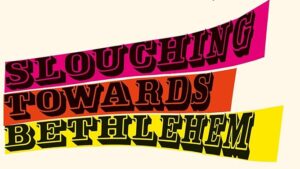Each month, we ask a member of faculty to tell us about one book that played an outsized role in making them who they are today. This month’s contribution to Words to Live By comes from Inglis Professor and Cohort Director of the first MFA in Fiction class, Stephen Kimber. His choice is from a writer who showed him there are many ways to tell a true story and introduced him to various writers reshaping the way we think about and write nonfiction.
What book have you chosen?
 Slouching Towards Bethlehem by Joan Didion (1968).
Slouching Towards Bethlehem by Joan Didion (1968).
How and when did you come across this book?
I was probably in my very early twenties when I read an essay by Harry Bruce, a Canadian nonfiction writer I admired. In the essay, Bruce had written about a writer he admired, an American named Joan Didion. So, I tracked down Didion’s first essay collection, Slouching Towards Bethlehem. Although most of the essays were previously published magazine stories, what amazing stories they were! Didion captured the ’60s in California with a voice that was spare but unsparing. She painted her characters with a brush that, as a New York Times reviewer put it, “makes them neither villainous nor glamorous, but alive and botched and often mournfully beautiful.” By the time I had finished the first few paragraphs of “Some Dreamers of the Golden Dream,” one of the book’s early essays about a woman who inexplicably murdered her husband ostensibly because “she wanted too much,” I was hooked.
What was it about the book that first stood out to you?
I could never write like Didion. I’m not sure I’d even want to, as beautifully rendered as her prose is. What reading Didion taught me is that there are many artful ways to tell a true story. And that writers of nonfiction can bring their own voice to their stories. For a young journalist in the 1970s, that was a liberating discovery.
How did this book shape you?
As impressive as her own writing was, Didion also opened a window for me into the work of other major nonfiction writers of the day—Tom Wolfe, Gail Sheehy, Gay Talese, Gloria Steinem, Hunter S. Thompson, Truman Capote, Norman Mailer and others—who collectively practiced what became known as New Journalism.
These were factual stories but with beginnings, middles and ends. The tales unfolded through in-the-moment scenes with actual dialogue featuring real characters and they were told by writers with distinct and distinctive voices.
Over the years, I’ve taught works by all those writers, but Didion remains a favourite. Since that first collection, she wrote ten more nonfiction books, including The Year of Magical Thinking, which won the National Book Award in 2005, not to forget five novels and a bunch of screenplays. I’ve read or watched most of them.
What do you think it is about this book that made such an impact?

It felt new and different at a time when the world was looking for new and different. You could have read any one of those stories in a magazine and thought, well, isn’t that interesting, and moved on. What gave them significance was bringing them together under one cover and showcasing that distinctive voice. Writers, including me, still study Slouching Towards Bethlehem to learn more about the art and craft of nonfiction writing.
Have you reread this book? Does it resonate differently today than it did on first reading?
I’ve re-read my way through three dog-eared, cover-torn copies of Slouching Towards Bethlehem and recently acquired an ebook version, which I will continue to consult from time to time when I need inspiration or a reminder of nonfiction’s possibilities.

